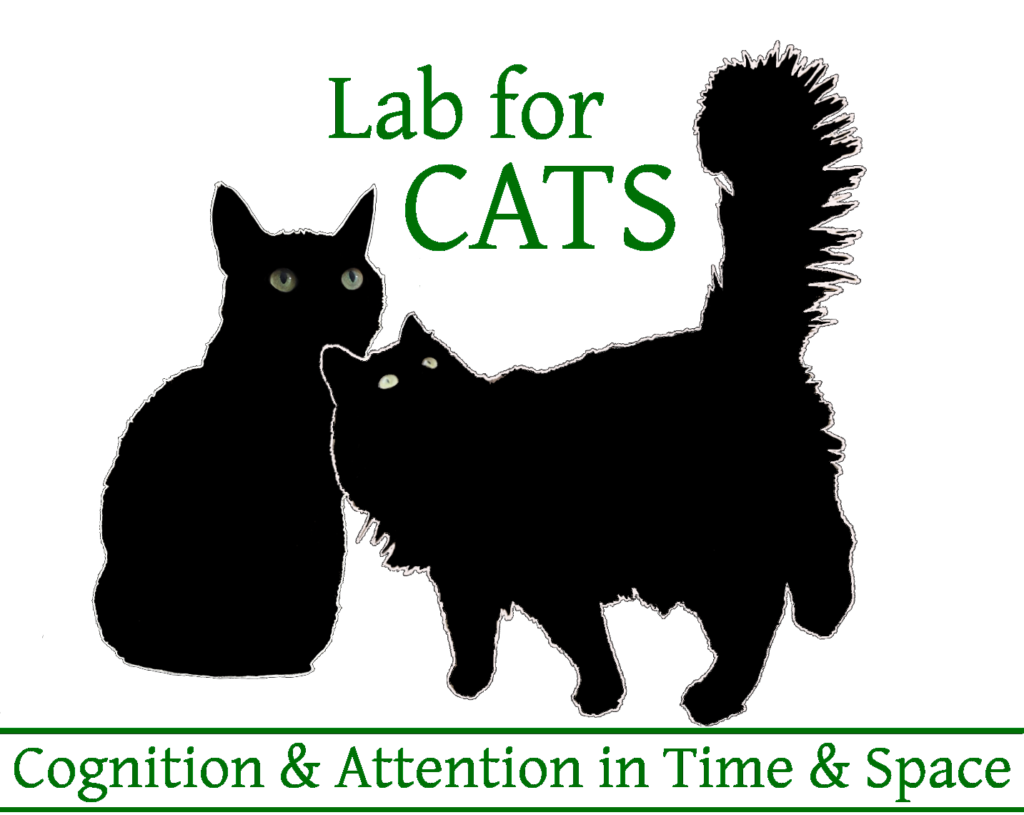Overview
My main research interest is visual attention, both animal and artificial. I am fascinated by the ability of humans and other animals to efficiently extract high quality, contextual visual information from the environment in a wide range of situations, and seek to better understand why artificial systems still struggle to achieve similar degrees of flexibility and robustness.
Laboratory for Cognition and Attention in Time and Space

At the Laboratory for Cognition and Attention in Time and Space (Lab for CATS), I work with students doing independent study projects during the academic year and full-time research over the summer term. We work on a variety of vision-related projects, with our most recent work predominantly following into one of three tracks:
- Spatiotemporal Visual Robustness: The analysis of videos adds an extra dimension (time) to the problem of image understanding. This vastly increases the combinatoric challenge of the stimuli, but can also introduce important new features, like motion, and constraints, such as temporal consistency. Our work tries to better understand the way in which learned models respond to different spatiotemporal features, with a primary goal of enhancing the robustness of these systems and developing new tests and metrics to ensure models aren’t relying on brittle features.
- Eye Tracking and Psychophysics of Attention: In collaboration with Professor Breeden, this is a collection of projects focused on understanding human visual cognition and attention. In addition to expanding our knowledge of how human vision works, one of the primary aims of this work is to identify aspects of visual processing that are currently poorly represented in artificial systems and, through improved understanding of biological vision, suggest novel mechanisms and approaches for artificial systems. Recent areas of focus include context in cinema, the role of novelty in search behaviour, and visual understanding under degraded image conditions.
- Spatial Vision: Understanding the three dimensional structure of the world from two dimensional images is a persistent visual challenge. While stereovision is well studied and one of the most common approach to depth perception, humans are still able to gather rich estimates of spatial structure from monocular images. Recent data-driven approaches in this domain have been gaining ground through models such as Depth Anything. Our work seeks to design new ways to test and characterize the behaviour of these monocular depth models.
Publications
Peer-Reviewed Journal and Conference Papers
Saeed Ghorbani, Calden Wloka, Ali Etemad, Marcus A. Brubaker, and Nikolaus F. Troje (2020) Probabilistic Character Motion Synthesis Using a Hierarchical Deep Latent Variable Model. Computer Graphics Forum Paper Link; Video Abstract; SCA 2020 Talk
John K. Tsotsos, Iuliia Kotseruba, and Calden Wloka (2019) Rapid visual categorization is not guided by early salience-based selection. PLOS ONE 14(10):1-23 Paper link
Iuliia Kotseruba, Calden Wloka, Amir Rasouli, and John K. Tsotsos (2019) Do Saliency Models Detect Odd-One-Out Targets? New Datasets and Evaluations. Proc. of British Machine Vision Conference (BMVC) – Oral Presentation PDF Dataset
Calden Wloka, Iuliia Kotseruba, and John K. Tsotsos (2018) Active Fixation Control to Predict Saccade Sequences. Proc. of Conference on Computer Vision and Pattern Recognition (CVPR) PDF
Calden Wloka and John K. Tsotsos (2016) Spatially Binned ROC: A Comprehensive Saliency Metric. Proc. of Conference on Computer Vision and Pattern Recognition (CVPR) Link
John K. Tsotsos, Iuliia Kotseruba, and Calden Wloka (2016) A Focus on Selection for Fixation. Journal of Eye Movement Research 9(5):2,1-34 Link
Neil D.B. Bruce, Calden Wloka, Nick Frosst, Shafin Rahman, and John Tsotsos (2015) On computational modeling of visual saliency: Examining what’s right, and what’s left. Vision Research 116:95-112 Link
Preprints and Technical Reports
Joshua Abraham and Calden Wloka (2021) Edge Detection for Satellite Images without Deep Networks arXiv paper
Calden Wloka and John K. Tsotsos (2020) An Empirical Method to Quantify the Peripheral Performance Degredation in Deep Networks arXiv paper
Calden Wloka, Toni Kunić, Iuliia Kotseruba, Ramin Fahimi, Nicholas Frosst, Neil D. B. Bruce, and John K. Tsotsos (2018) SMILER: Saliency Model Implementation Library for Experimental Research. arXiv paper GitHub repository
Invited Talks
Calden Wloka. “Modelling Fixations Beyond a Static Saliency Map.” Conference on Robots and Vision CIPPRS Award Talk, Burnaby BC, Canada, May 2021
Calden Wloka. “Some Salient Issues with Saliency Models.” A.I. Socratic Circles (AISC), Toronto ON, Canada, October 2020 Recorded talk
Calden Wloka. “Putting Computational Saliency in Context.” Facebook Reality Labs, Redmond WA, USA, January 2020
Calden Wloka. “An Overview of Computational Saliency.”Centre for Neuroscience Studies Seminar Series Queen’s University, Kingston ON, Canada, September 2014
Theses
Calden Wloka (2019) An Evaluation of Saliency and Its Limits. Doctoral Dissertation, York University PDF
Winner of the Canadian Image Processing and Pattern Recognition Society John Barron Doctoral Dissertation Award
Calden Wloka (2012) Integrating Overt and Covert Attention Using Peripheral and Central Processing Streams. Masters Thesis, York University PDF
Winner of the Joseph Liu Best Thesis Award and York University Thesis Award
